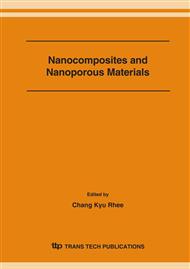p.267
p.271
p.275
p.279
p.283
p.287
p.291
p.295
p.299
Preparation and Characterization of Pt Counter Electrode with Buffer Layer for Dye-Sensitized Solar Cell
Abstract:
Dye-sensitized solar cell (DSSC) is of great interest as one of renewable energy sources. So far, many investigations related to TiO2 electrode, dye, electrolyte, Pt counter electrode, etc. were carried out. Here, we focus on Pt counter electrode for providing an enhanced catalytic property and physical stability. Pt has high-conductivity and superior catalytic properties. However, in case of Pt as counter electrode for DSSC, there exists partial problem due to poor adhesion between Pt and FTO glass. In this work, we tried to enhance the properties of Pt catalyst by two methods; first, the insertion of buffer layer under Pt thin film; second, the heat treatment of Pt films. We report the effect of buffer layer using Cr and Ti and the effect of heat treatment on Pt electrode under 400oC. Electrochemical characteristics of Pt electrodes were measured using electrochemical impedance spectroscopy and cyclic-voltammetry. A degree of electrode reaction, current density, electrode potential and interface resistance, etc were discussed with measured electrochemical data. In comparison with sputtered Pt counter electrode with and without buffer layers, heat-treated Pt counter electrode showed good performance in terms of the current density and interface resistance properties.
Info:
Periodical:
Pages:
283-286
Citation:
Online since:
January 2007
Authors:
Price:
Сopyright:
© 2007 Trans Tech Publications Ltd. All Rights Reserved
Share:
Citation:


